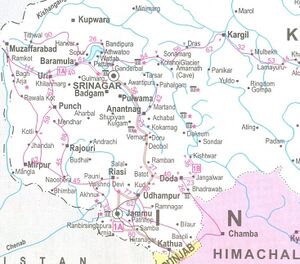Bhimber
| Author:Laxman Burdak, IFS (Retd.) |

Bhimber (भिंबर) (Bhimbar) is the chief town of Bhimber District, Azad Kashmir.
Location
The town is situated on the border between Azad Kashmir and Pakistan at a distance of about 50 km from Mirpur, about 48 kms from Gujrat, about 37 kms from Jhelum, about 166 kms from Islamabad and about 241 kmsfrom Srinagar.
Founders
Kotli (कोटली), Bhimbar (भींबर), villages in Sialkot and Chandovdala (चन्दोवडाला) at Manjha in Punjab were founded by Jats of Kalirana clan. Jhanwar (झवर) village was founded by Malji Kalirana clan about 800 years back. They people had settled in Siswada near Delhi and Hisar. Kalu came to Marwar and founded villages Mungda (मूंगड़ा), Kheda (खेड़ा), Mogda (मोगड़ा) etc. From there they came to Jhanwar. [1]
Jat clans
History
V. S. Agrawala[2] writes that Ashtadhyayi of Panini mentions janapada Uśīnara (उशीनर) (IV.2.118) - Panini mentions Ushinara as part of Vahika. Panini mentions three divisions of Vahika Country, viz Kekaya, Uśīnara and Madra. Fourth division to be added to Vahika country is Śavasa. Of these Kekaya and Śavasa may be located between Jhelum and Chenab, the first in the south and second in north respectively; Madra and Ushinara between the Chenab and Ravi River in the north and south respectively.
The Divyadana refers to the Shvasas in Uttarapatha with headquarters at Takshasila to which Ashoka was deputed by his father Bindusara as Viceroy to quell their rebellion. The name of Savasa or Shvasa seems to be preserved in in the modern name Chhiba comprising of Punchh, Rajauri and Bhimbhara. In literature Ushinaras are often associated with the Śibis (greek - Siboi) whose chief town Śibipura has been identified with Shorkot in Jhang district.
During the seventh century AD, the celebrated Chinese Buddhist monk, scholar, translator and pilgrim to India Hsuan Tsang mentioned Bhimber in his works. The works of Hsuan Tsang were translated into English in 1884 by Samuel Beal a scholar from England.
Bhimber has remained capital city of Chibhal, named after Raja Chib Chand the eldest son of Raja Partab Chand Katoch who came to Bhimber and established the state after marrying local ruler's daughter in 1400 A.D. Chibs are direct descendents of Raja Chib Chand Katoch.[3][4][5]
In Chibs, the first who embraced Islam was Shadaab Khan who is famous as Hazrat Baba Shadi Shaheed. His Hindu name was Raja Dharm Chand Chib. The last ruler of Chibhal was Raja Sultan Khan (1800–1840). Bhimber has been important strategically. It lies on the route that was followed by the Mughal Emperors for their frequent visits to the Kashmir Valley. It is also known as "Baab-e-Kashmir" (Door to Kashmir) because of its importance and geographical location which was ideal for Mughal Emperors to enter Kashmir. Therefore, the Mughals used Bhimber as a staging point for journey to Srinagar. Mughal Emperor Jahangir discussed Bhimber in his book Tuzk-e-Jahangiri. There live different caste peoples, in which mostly are Jatt secondly Rajpoot and 3rd are Mughal and some Gujjar and others.[6]
Alexander Cunningham[7] writes that....Rajaori and Kotali were held in later times by two branches of the royal family of Kashmir, to which they were usually tributary. But in the middle ages, under the Hindu rulers, Kotali formed part of Punach, to which it naturally belonged as part of the same valley. Bhimbar and Khariali were divisions of the Chibh, or Chibhan, branch of the Somvansi Rajas of Kangra and Jalandhar. In early times the name of Bhimbar was little used, the common appellation being Chibhan, which is found in Sharifuddin's history of Timur, under the form of Jibhal. The conversion of the family to Muhammadanism is probably of late date, as Ferishta mentions Howns Raja of Bhimbar in a.h. 891, or A.D. 1486.[8] But so many of these hill chiefs retained their Hindu names after they became Muhammadans, that the Hindu name alone cannot be taken as a decisive proof of his being unconverted. Kashtwar and Bhadrwar are situated on opposite banks of the upper Chenab river, to the south-east of Kashmir, to which they were generally subject. These nine chief-ships of the central division, added to the thirteen of the western division, form the twenty-two Muhammadan states which the popular belief assigns to the western half of the Alpine Panjab.
[p.135]: I may remark that all the chiefs of the Central Division, whose genealogies I possess, trace their origin to the Surajvansi, or Solar Race, with the single exception of the intrusive Chibban of Bhimbar.
छिमाल
विजयेन्द्र कुमार माथुर[9] ने लेख किया है ...छिमाल (AS, p.349) प्राचीन अभिसारी राज्य का प्रदेश, जिसमें चिनाब नदी के पश्चिम में स्थित पूंछ, राज़ोरी और भिंभर का क्षेत्र सम्मिलित है।
References
- ↑ Jat Bandhu, 25 September 2007
- ↑ V. S. Agrawala: India as Known to Panini, 1953, p.53
- ↑ Gulabnama of Diwan Kirpa Ram: A History of Maharaja Gulab Singh of Jammu & Kashmir, page 41
- ↑ History of the Punjab Hill States "by Hutchison and Vogel, reprinted edition, 2 volumes in 1 CHAPTER XX IV. 1933 AD
- ↑ The Ancient Geography of India by Alexander Cunningham, page 134, 1871
- ↑ Government of Azad Jammu & Kashmir Website. "Jahangir discussed Bhimber in his book Tuzk-e-Jahangiri."
- ↑ The Ancient Geography of India/Singhapura,p.134-135
- ↑ Briggs, 'Ferishta,' iv. 483.
- ↑ Aitihasik Sthanavali by Vijayendra Kumar Mathur, p.349